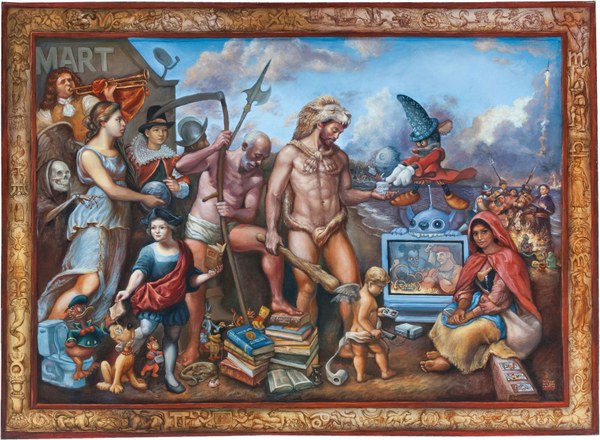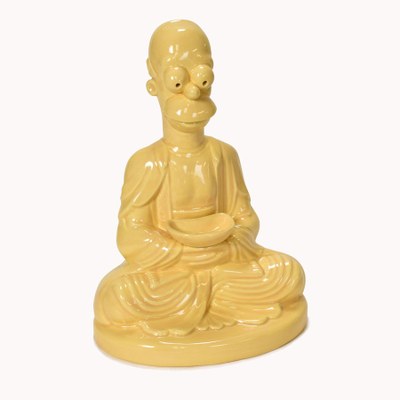Wit, Humor, and Satire
June 25, 2022-January 29, 2023. This exhibition revealed how humor, wit, and satire function as tools to make us laugh, shine a light on society and human behaviors, and serve as mechanisms for survival.

Patrick McGrath Muñiz, The Disneyfication of a Hero, 2010, oil on canvas, Albuquerque Museum, gift of Patrick McGrath Muñiz and the Jane Sauer Gallery, PC2012.27.1
Legend to The Disneyfication of a Hero (PDF)
Thomas J. Lane, Enlightened at Last, 2004, ceramic, Albuquerque Museum, gift of Ray Graham, PC2020.8.113
What makes a joke funny? What makes a pun witty? What makes a political cartoon biting? Wit, humor, and satire have been deployed in the visual arts across time and cultures, as evidenced in the works presented in this exhibition. Prints, paintings, sculpture, photography, and more provide examples of how humor, wit, and satire function as tools to make us laugh, shine a light on society and human behaviors, and serve as mechanisms for survival. Though wit, humor, and satire take form across the arts, including literature, film, and music, they are also valued as complex approaches to making images. Humor is understood as a feeling, something that makes you laugh. Wit is an intelligent use of images, words, or ideas that are amusing but not necessarily humorous. Satire often uses humor, wit, and irony to ridicule or expose the foibles and follies of human situations.
Many works presented here use these devices to juxtapose the familiar with the unexpected. Some artists incorporate universal meanings that everyone can relate to, while others create works that require specific knowledge of individuals or events to grasp the meaning of the art. The artists explore themes and issues related to politics, culture, everyday life, and the environment. The exhibition revealed the power of the visual arts to shape ideas and expose or question underlying truths. Some works in this exhibition were light-hearted and funny, while others depicted quite serious or even tragic situations. Each of the works showed how wit, humor, and satire often work to subvert or undermine established power dynamics.
Another key characteristic of visual representations of wit, humor, and satire is the tendency to defy categorization and inhabit other genres of art. For example, caricature, the exaggeration of the figure, challenges how portraiture has been defined throughout art history. Like Andy Warhol’s Mao series, works in this exhibition tend to question what makes art “fine art” and ask if the message prevails over the medium or if perhaps both are important. Reimagining how people, place, and politics have played a role in defining fine art over centuries is central in some of the works presented.
The sections titled The Human Condition and Challenging Standards of Femininity included works that capture the mundane to ritual practices like marriage. These sections poked fun at how people treat each other and how social, moral, and religious systems shape life and even perspectives on death. Exploring Wit through Words and Materials and Art History Jokes drew attention to artists who both critique the art world and participate in experimenting with different materials and methods of image-making. Portraiture and Politics provided numerous examples of political satire, in which the artist attacks a specific individual to ridicule and bring down those with more power. In contrast, Humor as Resilience showed how artists use humor to elevate and uplift members of communities that have been oppressed and feel powerless at times. The remaining sections tackled social and political issues, including the environment, consumption and commodification, war, and the history of the Western United States.
The works in this exhibition demonstrated how the viewer's participation is an essential element across these approaches to making images. The viewer has to grapple with, make meaning of, and decide what they take away from each work of art.
This exhibition was curated by Albuquerque Museum with works from the museum’s collection.
Details subject to change.

